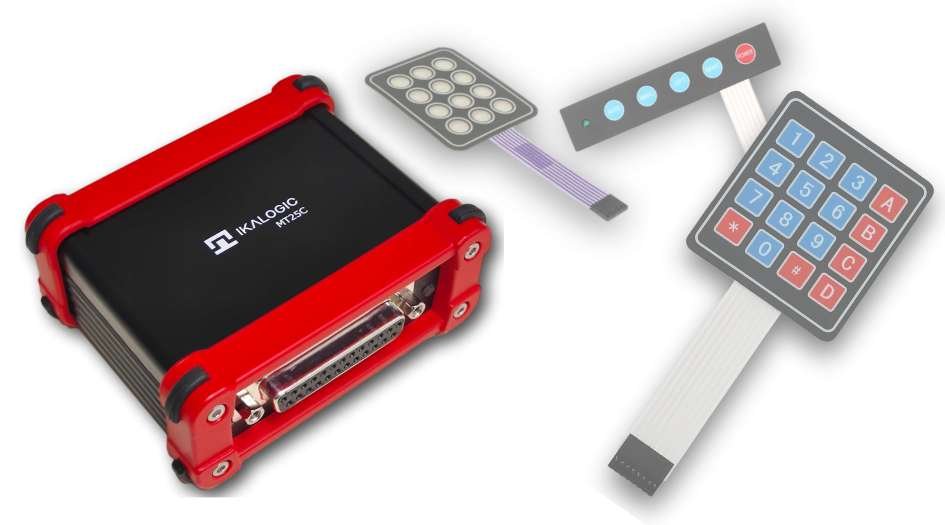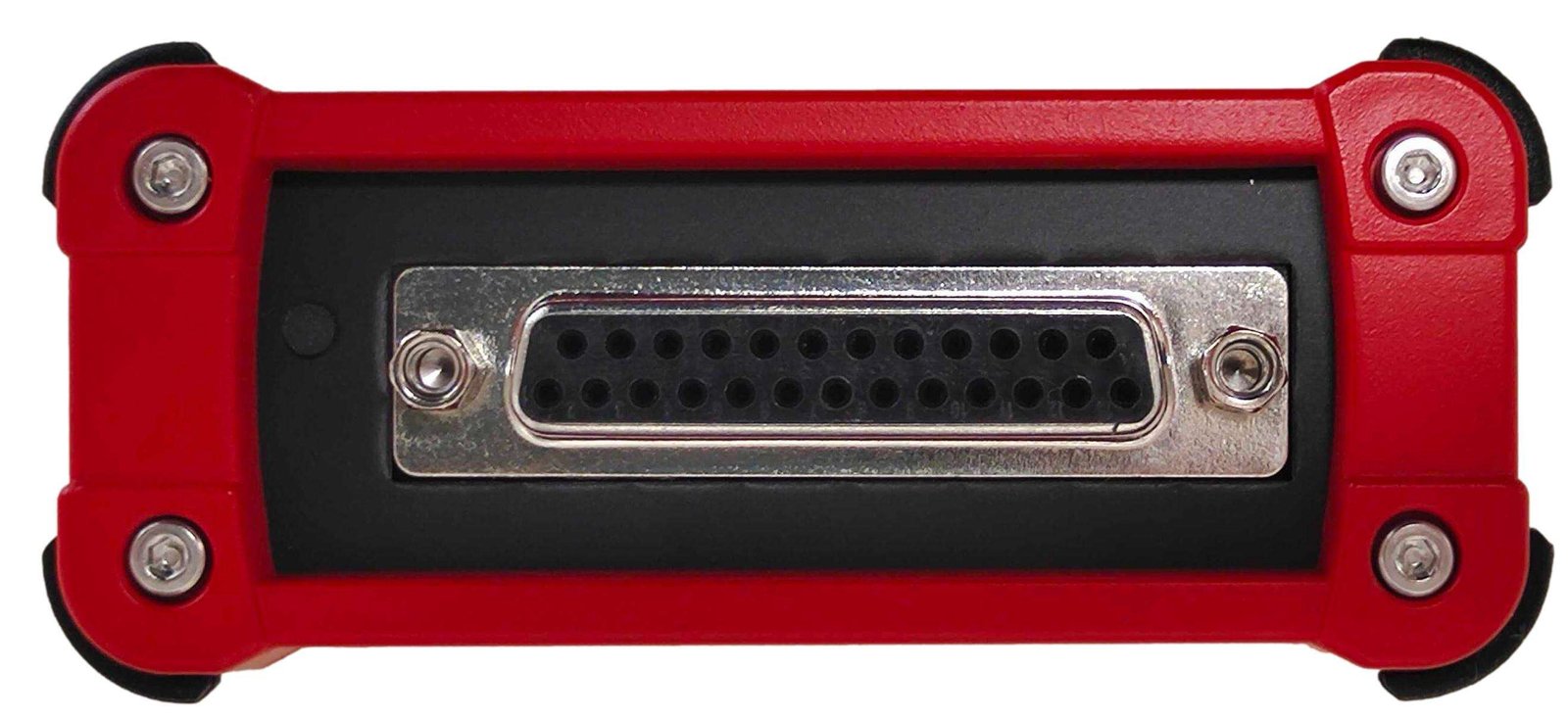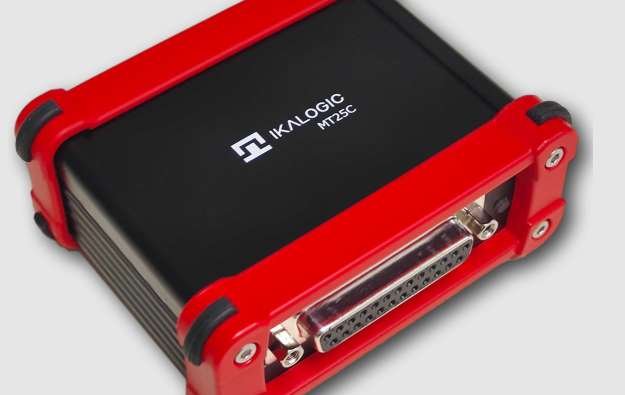MT25C Keypad & LEDs tester
Automated Testing for Keypads, LEDs, and Capacitive switches
The MT25C is a compact and versatile testing platform designed to automate the validation of human-machine interface (HMI) components, including keypads, LEDs, and capacitive touch buttons. It verifies the correct electrical behavior of keys, checks LED functionality, and detects the activation of capacitive buttons, ensuring the reliability of control panels and user interfaces.
- 25 configurable pins
- Mechanical & Capacitive Switch Testing
- LED Testing
- Seamless integration
The MT25C gives you 25 hardware pins that you can configure your way. Each pin can act as a button input, LED driver or common line, no limitations.
Whether you're testing a complex switch matrix or a custom control panel, this flexible pin setup adapts to your keypad’s exact wiring, saving you hours of custom jig design and rewiring.
From classic tactile buttons to sleek capacitive touchpads, MT25C is built to test them all.
Whether you’re working with single switches or full 4x4 matrix keypads, MT25C scans and verifies each keypress with precision. It can also interface with capacitive switches, validating touch response and sensitivity without additional hardware.
MT25C verifies LED polarity by measuring forward voltage drop.
Incorrectly mounted LEDs are instantly detected, and color identification is performed electrically by analyzing the diode’s forward voltage—no camera required. This enables fast, low-cost verification of LED orientation and type directly through the test interface.MT25C is designed to fit seamlessly into your existing test environment. It doesn't require any proprietary software or complex installation. Once connected, it appears as a standard virtual COM port on your PC.
Python, LabVIEW, C#, or Node.js—whatever your environment, integration is straightforward. Communication is based on compact binary packets, enabling efficient and reliable data exchange. This minimal protocol design simplifies development and debugging, while ensuring fast execution and easy maintenance. Ideal for both R&D setups and high-throughput production lines.
MT25C operation
MT25C is designed to accelerate the testing of membrane keypads. A typical test sequence looks like this:
- Connect the keypad to the MT25C — it gets auto-detected instantly
- Launch a static test to detect short circuits, open lines, and LED functionality
- The operator presses each key — real-time feedback confirms proper operation
- User software controls the whole process by sending serial commands to the MT25C.

MT25C
- 25 configurable pins
- USB interface and powered
- Single buttons or matrix
- Capacitive touch button support
- LED testing
Applications
- Functional testing of membrane keypads and switch matrices
- Verification of capacitive touch inputs
- Polarity and color validation of indicator LEDs
- End-of-line testing for control panels and HMI assemblies
- Integration into custom automated test benches
Benefits
- Fast and reliable detection of wiring faults and misassembled components
- No bulky software—simple serial interface for easy integration into a GO/NO-GO test
- Configurable pinout adapts to any keypad layout
- No need for vision systems to test LEDs
- Compact, affordable solution for both R&D and production environments
Frequently Asked Question
Is the pin configuration fixed, or can I reassign pin roles?
No, the pin configuration is fully programmable. Each of the 25 pins on the MT25C can be configured individually as a logic input/output, LED anode or cathode, or shared/common line. This flexibility allows you to adapt the interface to any keypad or switch layout without rewiring or redesigning test fixtures.
What type of connector or interface does MT25C use?
MT25C connects to the host PC via USB and appears as a standard virtual COM port. The test interface itself is a DB 25 connector designed to handle customizable digital and analog I/O. No proprietary hardware interface or adapter is needed—just a USB cable and your preferred connection to the keypad under test.
Can I use MT25C to test both mechanical and capacitive switches?
Yes, MT25C supports both mechanical and capacitive switch testing. For mechanical keypads, it performs scanning and contact verification. For capacitive switches, it generates appropriate test signals and reads back the capacitive switch response to confirm proper behavior.
What software is required to operate the MT25C?
None. MT25C does not rely on dedicated PC software or drivers. It operates over a standard serial interface using simple binary commands. This makes it ideal for integration into existing test systems without adding software complexity.
To help you get started, we provide a simple GUI application that demonstrates the MT25C's capabilities. This GUI is not required for operation but can be useful for initial testing and configuration. This GUI will also provide the detailed packet structure and commands used to communicate with the MT25C.
How do I communicate with MT25C from Python or LabVIEW?
Since MT25C appears as a standard COM port, you can communicate with it using any language that supports serial communication. In Python, you can use the pyserial library. In LabVIEW, you can use VISA or native serial functions. Communication is done via compact binary packets defined in the MT25C protocol documentation.